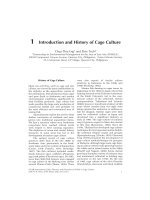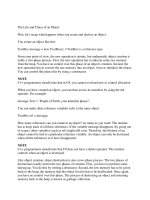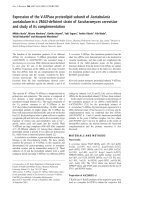Chapter I The Introduction And Overview Of The Subject
Bạn đang xem bản rút gọn của tài liệu. Xem và tải ngay bản đầy đủ của tài liệu tại đây (2.73 MB, 25 trang )
CHAPTER I : INTRODUCTION AND OVERVIEW
OF THE RAPID TRANSIT
Contents
Chap
1
Introduction of the rapid transit
1. Definition of rapid transit and metro.
2. Kinds of the rapid transits
3. Distinguish among different kinds of rail way
2
Fundamental of the metro components
1. Terminology of the metro.
2. Historical of the metro.
3. Operations and kinds of aglinement line styles
4. Keywords and vocabulary summarise.
Chương
Nội dung
3
Metro system aglinement
1. The global planning phase of the 3rda Ben Thanh – Tan Kien
2. The 3rd a Ben Thanh – Tan Kien alignments
3. Characters of the metro system
4. Keywords and vocabulary summarise
Metro Station Components
4
1. Achitecture of the station
2. The design and requirement of use and technique
3. Station characteristics
4. Keywords and vocabulary summarise
Chương
Nội dung
5
Rail Structure Components
1. Introduction of rail structure components
2. Technical drawings and it’s components
3. Structure of the overground tracks segment
4. Structure of the underground tracks segment
5. Structure of the viaduct tracks segment
6. Keywords and vocabulary summarise
Construction of the tunnels with TBM technique
6
1. Cut, cover and excavation in station’ the contruction phase
2. Introduction of the TBM technique for excavating tunnel
3. Keywords and vocabulary summarise
A.
Assessments
1
Report and Presentation
2
Final test
B.
Class activities
3
Work in group
4
Discussion and report before class
5
Reading and Writing
1
Work in small groups
2
Real projects based study
3
Discussion and confident communication
4
Keywords take note
No phone on class
Nội dung môn học
Rapid transit, also known as metro, subway, underground, or colloquially
as "the train", is a type of high-capacity public transport generally found
in urban areas.
Unlike buses, trams or light rail, rapid transit systems are electric railways
that operate on an exclusive right-of-way, which cannot be accessed by
pedestrians or other vehicles of any sort, and which is often grade
separated in tunnels or on elevated railways.
→ What is the substances of the passages ?
❖Answer:
→ Which keywords you are familiar ? What are they meaning ?
❖Answer:
→ Can you describe these keywords in Vietnammese ?
❖Answer:
Keywords:
No.
Keywords
1
Rapid transit
2
High-capacity public transport
3
Urban
4
Public transport
5
Tram
6
Light rail
7
Bus
8
Pedestrians
9
Vehicles
10
Exclusive right-of-way
Meanings
I.1. Deffination of rapid transit and metro.
Modern services on rapid transit systems are provided on designated
lines between stations typically using electric multiple units on rail
tracks, although some systems use guided rubber tyres, magnetic
levitation, or monorail.
The stations typically have high platforms, without steps inside the
trains, requiring custom-made trains in order to avoid gaps. They are
typically integrated with other public transport and often operated by
the same public transport authorities.
It is unchallenged in its ability to transport large numbers of people quickly
over short distances with little use of land. Variations of rapid transit
include people movers, small-scale light metro, and the commuter rail
hybrid S-Bahn.
Keywords:
No.
Keywords
Meanings
1
Electric multiple units
is a multiple unit train consisting of self-propelled carriages using electricity as the motive
power
2
Rail track
Keywords:
No.
Keywords
3
Guided rubber tyre
4
Magnetic levitation
Meanings
Keywords:
No.
Keywords
5
Monorail
6
Station
Platform
Meanings
Keywords:
No.
Keywords
7
Commuter rail hybrid S-Bahn
Meanings
Figue 1. Light rail
Figue 2. Metro
Figue 3. Commuter railway
? Can you distinguish among three types of rail way
? What is the best advantage of the metro
? Can you list some kinds of metro rail way
→ Who is the group which be the first and best of translation all the
passages ?
→ +5 points will be added for the best group !
Read more about the history
The world's first rapid-transit system was the partially underground Metropolitan
Railway which opened as a conventional railway in 1863, and now forms part of
the London Underground. In 1868, New York opened the elevated West Side and Yonkers
Patent Railway, initially a cable-hauled line using static steam engines.
The world's largest rapid transit network is the Greater Tokyo rail system with
more than 40 million daily passengers and 882 stations within the metropolis. The
world's largest single rapid transit service provider by both length of track (842 miles
(1,355 km), including non-revenue track
Read more about the history
The world's first rapid-transit system was the partially underground Metropolitan
Railway which opened as a conventional railway in 1863, and now forms part of
the London Underground. In 1868, New York opened the elevated West Side and Yonkers
Patent Railway, initially a cable-hauled line using static steam engines.
Read more about the history
The world's largest rapid transit network is the Greater Tokyo rail system with
more than 40 million daily passengers and 882 stations within the metropolis. The
world's largest single rapid transit service provider by both length of track (842 miles
(1,355 km), including non-revenue trackand number of stations (468 stations in total) is
the New York City Subway. By length of passenger route, the world's longest single-
operator rapid transit system is the Shanghai Metro. The busiest rapid transit systems in
the world by annual ridership are the Tokyo subway system, the Seoul Metropolitan
Subway, the Moscow Metro, the Beijing Metro, and the Shanghai Metro
Read more about the history
The opening in 1863 of London's steam-hauled Metropolitan Railway marked the
beginning of rapid transit. Initial experiences with steam engines, despite ventilation, were
unpleasant. Experiments with pneumatic railways failed in their extended adoption by cities.
Electric traction was more efficient, faster and cleaner than steam and the natural choice for
trains running in tunnels and proved superior for elevated services. In 1890 the City & South
London Railway was the first electric-traction rapid transit railway, which was also fully
underground. Both railways were eventually merged into London Underground. The
1893 Liverpool Overhead Railway was designed to use electric traction from the outset.
Read more about the history
The technology quickly spread to other cities in Europe, Canada and the United
States with some railways being converted from steam and others being designed to be
electric from the outset. Budapest in Hungary and Glasgow, Chicago and New York all
converted or purpose-designed and built electric rail services.There were 19 systems by
1940, and 66 by 1984. Cities such as Oslo and Marseille opened extensive systems in the
1960s and many new systems were introduced in Southeast Asia and Latin America.
Read more about the history
Advancements in technology have allowed new automated services. Hybrid
solutions have also evolved, such as tram-train and premetro, which incorporate some of
the features of rapid transit systems. In response to cost, engineering considerations and
topological challenges some cities have opted to construct tram systems .









